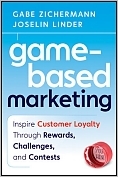| |||||
• polskie
• Zamów informacje o nowościach z wybranego tematu • kontakt |
GAME-BASED MARKETING: INSPIRE CUSTOMER LOYALITY THROUGH REWARDSZICHERMAN G. LINDER J. / CHALLENGES AND CONTENTSwydawnictwo: WILEY, 2010, wydanie Icena netto: Game-Based Marketing: Inspire Customer Loyalty Through Rewards, Challenges, and Contests Harness the power of games to create extraordinary customer engagement with Game-Based Marketing. Gamification is revolutionizing the web and mobile apps. Innovative startups like Foursquare and Swoopo, growth companies like Gilt and Groupon and established brands like United Airlines and Nike all agree: the most powerful way to create and engage a vibrant community is with game mechanics. By leveraging points, levels, badges, challenges, rewards and leaderboards – these innovators are dramatically lowering their customer acquisition costs, increasing engagement and building sustainable, viral communities. Game-Based Marketing unlocks the design secrets of mega-successful games like Zynga’s Farmville, World of Warcraft, Bejeweled and Project Runway to give you the power to create winning game-like experiences on your site/apps. Avoid obvious pitfalls and learn from the masters with key insights, such as:
And learn even more:
Based on the groundbreaking work of game expert and successful entrepreneur Gabe Zichermann, Game-Based Marketing brings together the game mechanics expertise of a decade’s worth of research. Driven equally by big companies, startups, 40-year-old men and tween girls, the world is becoming increasingly more fun. Are you ready to play? Gabe Zichermann is the father of Funware theory and CEO of beamME—the world's most popular mobile networking platform for professionals. He is a twelve-year game-industry veteran, having worked for CMP Media as the director of marketing for the Game Developers Conference, Gamasutra, and Game Developer magazine, as well as helping to launch and guide Trymedia Systems from start to sale as the first successful online game DRM and distribution company. A resident of New York City, Gabe blogs about games and society at funwareblog.com. Joselin Linder is a pop culture writer, filmmaker, and entrepreneur. She currently lives in Brooklyn. Table of Contents Acknowledgments. Foreword (Robin Kent). Introduction. CHAPTER 1 The Argument for Loyalty. ‘‘Stickiness’’ Is Loyalty. Playing with Loyalty. The Future of Loyalty—Frequent Flyer Games. Communities of Influence: Flyertalk. Funware: Putting Fun into Everything. Chase ‘‘Goes Dutch’’. The Value of Prizes. Game Mechanics. Don’t Hate the Player, Hate the Game. CHAPTER 2 Passive Play. The Incidental Games We Play. Latte Leaders: Status and Levels. Black Cards and Red Carpets. Keeping Score. The Subway Scrum: Rules of Play. The Bar Brawl: Demonstrable Status. The Components of Funware. CHAPTER 3 Social Networks and Leaderboards. Social Network Clutter. Marketing with Social Networks. Orkut: A Case Study in Leaderboard Effectiveness. Funware at Work: Facebook Friend Games. No News Isn’t Good News. Leaderboards in Business. The Jigsaw Example. Correctly Using Leaderboards. Points Proxy: Masking and Directing Behaviors. Wal-Mart and the Theory of Relativism. Leaderboard Levels. Leaderboards: The Top 10. CHAPTER 4 Funware Mechanics: Points and Beyond. Making Points the Point. Point Mechanics and Branding. Virtual Economics. Virtual Currency. Real-World Value versus Virtual Value. Creating an Easy and Effective Virtual Economy. Badging Players. Newbie Badges. Building Levels. America’s Army. Defining and Meeting Goals. Bringing Players into the Game. Tracking Behavior. Meaningful Status Displays. CHAPTER 5 Prizes and Games of Chance. The Ansari X PRIZE: The Power of Games to Change the World. Can’t Buy Me Love: Choosing Prizes. Games of Chance. Games of Chance and the Law. McDonald’s Monopoly Game: A Case Study. The Value of a Prize. Long-Term Motivation and Customer Loyalty. Gaming the System. Amazon Reviews: Community Policing at Its Finest. Using Sweepstakes to Fight Gaming. Virtual Points and Prizes. CHAPTER 6 The Ultimate Funware: Frequent Flyer Programs. Frequent Flyer Programs Take Off. What Business Are Airlines In?. Designing the Frequent Flyer Massive Multiplayer Online Game. The Power of Points. Getting There without Points. Real-World Redemptions: Do They Matter?. The Solution Is Virtual Goods. But Does Redemption Matter?. Levels and Badges in FFPs. Throwing Your Weight Around. Benefits of Status. The Level Error of FFPs. Going Above and Beyond: The Boss Level. Challenges and Contests. United’s Team Challenge. Making It Work for You. CHAPTER 7 Know Thy Player. Bartle’s Player Types. Achievers (¦). Socializers (¦). Explorers (¦). Killers (¦). The Naive Player. Competitiveness: The Most Important Motivation? Closing the Gender Gap. Nike+: Early Adopter Advantage. Fahrvergnügen’s Failure. The Wrap-Up. CHAPTER 8 The Future of Gamers: Generation G. A Generation Gap. What Makes Generation G Special? The Trends. Smith & Tinker. The Gulf Is Real. The Effect of Games: Tetris, Team Building, and Tug of War. The Character of a Generation of Gamers. Conclusion: Successfully Marketing to Generation G. CHAPTER 9 Motivating Sales with Funware: Getting Employees into the Game. Front Line and Top of Mind. Bitten by the Achievement Bug. Mary Kay: Generating Loyalty. Trust and Motivational Funware. Sales Teams and Customer Trust: Pep Boys. Making the Corporate Personal through Games. Funware at Work: Wells Fargo’s Stagecoach Island. Playing Together. CHAPTER 10 Everyone Wins: Games in Your Business. Product Power. Advergames and In-Game Advertising. Pursuing, Engaging, and Rewarding Customers: The Business of Lifestyles. Arming Your Business. First Steps Are the Hardest. Do It for the Children. Funware on the Rise. References. Index. 240 pages, Hardcover Księgarnia nie działa. Nie odpowiadamy na pytania i nie realizujemy zamówien. Do odwolania !. |


